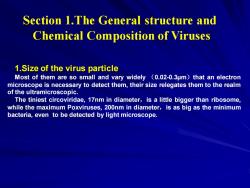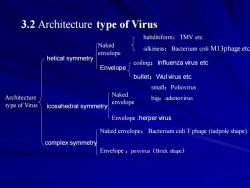南京师范大学:《微生物学》课程PPT教学课件(英文版)Chapter 4 The Viruses

Chapter 4 Viruses
Chapter 4 Viruses

The concept of viruses Viruses are a unique group of tiny infectious particles that are obligate parasites of cells,are not cells but resemble complex molecules composed of DNA or RNA.Most of them are so small (0.02-0.3um)that an electron microscope is necessary to detect them
The concept of viruses Viruses are a unique group of tiny infectious particles that are obligate parasites of cells, are not cells but resemble complex molecules composed of DNA or RNA. Most of them are so small (0.02-0.3µm) that an electron microscope is necessary to detect them

Classification of the viruses: Viruses Non-cell organism Viroids Prions Subviral agents Satellites and Deltavirus
Classification of the viruses: Viruses Subviral agents Viroids Prions Satellites and Deltavirus Non-cell organism

Characteristics of virions (virus particles): 1)are tiny particles that are ultramicroscopic size,can go through the bacteria filter. 2)are not cell but composed of protein and nucleic acid 3)Nucleic acid can be either DNA or RNA but not both. 4)use themselves nucleic acid to replicate and apply the assembling of viral protein and nucleic acid to multiply massively. 5)are obligate intracellular parasites and lack enzymes for most metabolic processes and synthesizing protein,multiply by taking control of host cell's metabolism and synthetic machinery. 6)are abiotic macromolecular and contain the infectivity for a long time outside of the host cell. 7)are not sensitive to antibiotic but sensitive to interferon. 8)Some of them can be integrated into the host cell's genome in provirus
Characteristics of virions (virus particles): 1)are tiny particlesthat are ultramicroscopic size, can go through the bacteria filter . 2)are not cell but composed of protein and nucleic acid 3)Nucleic acid can be either DNA or RNA but not both. 4)use themselves nucleic acid to replicate and apply the assembling of viral protein and nucleic acid to multiply massively. 5)are obligate intracellular parasites and lack enzymes for most metabolic processes and synthesizing protein, multiply by taking control of host cell’s metabolism and synthetic machinery. 6)are abiotic macromolecular and contain the infectivity for a long time outside of the host cell. 7)are notsensitive to antibiotic but sensitive to interferon. 8)Some of them can be integrated into the host cell’s genome in provirus

Significance of virus research 1)Control and eliminate the aversive viruses,which do harm to the human health and the domestic animals.The national economy is severely affected by the virus diseases.In fermentation industry ,contamination of phages will have bad influence in the fermentation production. 2)By study of the virus,we can upgrade the species,cultivate live virus vaccine strain,protect the ecological environment,apply virus as insecticida and use them as vectors for gene engineering
Significance of virus research : 1) Control and eliminate the aversive viruses, which do harm to the human health and the domestic animals. The national economy is severely affected by the virus diseases. In fermentation industry ,contamination of phages will have bad influence in the fermentation production. 2) By study of the virus, we can upgrade the species, cultivate live virus vaccine strain, protect the ecological environment, apply virus as insecticida and use them as vectors for gene engineering

Section 1.The General structure and Chemical Composition of Viruses 1.Size of the virus particle Most of them are so small and vary widely (0.02-0.3pm)that an electron microscope is necessary to detect them,their size relegates them to the realm of the ultramicroscopic. The tiniest circoviridae,17nm in diameter,is a little bigger than ribosome, while the maximum Poxviruses,200nm in diameter,is as big as the minimum bacteria,even to be detected by light microscope
Section 1.The General structure and Chemical Composition of Viruses 1.Size of the virus particle Most of them are so small and vary widely (0.02-0.3µm)that an electron microscope is necessary to detect them, their size relegates them to the realm of the ultramicroscopic. The tiniest circoviridae, 17nm in diameter,is a little bigger than ribosome, while the maximum Poxviruses, 200nm in diameter,is as big as the minimum bacteria, even to be detected by light microscope

2.Structure of viruses Nucleic acid Spike 2 核酸 8 caps 衣壳粒 capsomere 亵腹 The mode of naked nucleocapsid virus
2. Structure of viruses The mode of naked nucleocapsid virus有囊膜病毒模式结构 sid Cap capsomere Nucleic acid id caps Spike

DNA/RNA Centrel Genome:Double/single strand core sectile/unsectile Nucleocapsid (Basic Unit) Capsid Capsomer 多肽 Virus (结构亚单位) particle Envelopewith Spike (nonbasic Unit) Component of virus particle
Virus particle Nucleocapsid (Basic Unit) Envelopewith Spike (nonbasic Unit) Centrel core Capsid DNA/RNA Genome:Double/single strand sectile/unsectile 多肽 (结构亚单位) Capsomer Component of virus particle

3.Morphology and symmetry of viruses 3.1 Morphology of Virus (c)Herpesvirus (d)Orf virus (a)Vaccinia (b)Paramyxovirus virus (mumps) (h)Adenovirus (e)Rhabdovirus (g)Flexuous- (f)T-even coliphage tailed phage (i)Influenza virus 到 @ (m)Tubulovirus (i)Polyomavirus (k)Picornavirus (I)X174 phage 1 um
3. Morphology and symmetry of viruses 3.1 Morphology of Virus

3.2 Architecture type of Virus habditiform:TMV etc (Naked silkiness: Bacterium coli M13phage etc envelope helical symmetry coiling: Influenza virus etc Envelope bullet:Wut virus etc small:Poliovirus Architecture Naked big:adenovirus type of Virus icosahedral symmetry envelope Envelope herper virus Naked envelope:Bacterium coli T phage (tadpole shape) complex symmetry Envelope poxvirus (Brick shape)
3.2 Architecture type of Virus helical symmetry icosahedral symmetry complex symmetry Naked envelope habditiform:TMV etc silkiness:Bacterium coli M13phage etc coiling:Influenza virus etc bullet:Wut virus etc Envelope Naked envelope Envelope :herper virus small:Poliovirus big:adenovirus Envelope :poxvirus(Brick shape) Naked envelope: Bacterium coli T phage (tadpole shape) Architecture type of Virus
按次数下载不扣除下载券;
注册用户24小时内重复下载只扣除一次;
顺序:VIP每日次数-->可用次数-->下载券;
- 南京师范大学:《微生物学》课程PPT教学课件(英文版)Chapter 3 Eukaryotic Microorganism.ppt
- 南京师范大学:《微生物学》课程PPT教学课件(英文版)Chapter 2 Prokaryotic Microorganism.ppt
- 南京师范大学:《微生物学》课程PPT教学课件(英文版)Chapter 1 Introduction of Microbiology.ppt
- 南京师范大学:《微生物学》课程PPT教学课件(中文版)第九章 微生物的生态(microbiological ecology).ppt
- 南京师范大学:《微生物学》课程PPT教学课件(中文版)第八章 微生物遗传学.ppt
- 南京师范大学:《微生物学》课程PPT教学课件(中文版)第七章 微生物生长.ppt
- 南京师范大学:《微生物学》课程PPT教学课件(中文版)第六章 微生物代谢调节.ppt
- 南京师范大学:《微生物学》课程PPT教学课件(中文版)第五章 微生物的营养与培养基.ppt
- 南京师范大学:《微生物学》课程PPT教学课件(中文版)第四章 病毒.ppt
- 南京师范大学:《微生物学》课程PPT教学课件(中文版)第三章 真核微生物.ppt
- 南京师范大学:《微生物学》课程PPT教学课件(中文版)第二章 原核微生物.ppt
- 南京师范大学:《微生物学》课程PPT教学课件(中文版)第一章 绪论 Microbiology.ppt
- 南京师范大学:《微生物学》课程PPT教学课件(中文版)第十章 传染与免疫.ppt
- 江南大学:《微生物学》课程教学资源(PPT课件)第七章 微生物生态和废水的生物处理.ppt
- 江南大学:《微生物学》课程教学资源(PPT课件)第六章 微生物菌种的选育.ppt
- 江南大学:《微生物学》课程教学资源(PPT课件)第五章 环境因子对微生物生长和代谢的影响.ppt
- 江南大学:《微生物学》课程教学资源(PPT课件)第四章 微生物的代谢与调节及其人工控制.ppt
- 江南大学:《微生物学》课程教学资源(PPT课件)第三章 微生物的营养与生长.ppt
- 江南大学:《微生物学》课程教学资源(PPT课件)第一章 绪论 Microbiology(主讲:樊游).ppt
- 江南大学:《微生物学》课程教学资源(实验讲义)实验十三 酒曲或其他样品中某类特定微生物的 分离纯化(设计).doc
- 南京师范大学:《微生物学》课程PPT教学课件(英文版)Chapter 5 Microbial Nutrition and Culture Medium.ppt
- 南京师范大学:《微生物学》课程PPT教学课件(英文版)Chapter 6 Microbial Metabolism.ppt
- 南京师范大学:《微生物学》课程PPT教学课件(英文版)Chapter 7 Microbial Growth.ppt
- 南京师范大学:《微生物学》课程PPT教学课件(英文版)Chapter 8 Microbial Genetics.ppt
- 南京师范大学:《微生物学》课程PPT教学课件(英文版)Chapter 9 Microbial Ecology.ppt
- 南京师范大学:《微生物学》课程PPT教学课件(实验指导)实验十 细菌的凝集反应.ppt
- 南京师范大学:《微生物学》课程PPT教学课件(实验指导)实验十一 水的微生物学检查.ppt
- 南京师范大学:《微生物学》课程PPT教学课件(实验指导)实验一 细菌的单染色及油镜的使用.ppt
- 南京师范大学:《微生物学》课程PPT教学课件(实验指导)实验二 革兰氏染色及细菌特殊结构观察.ppt
- 南京师范大学:《微生物学》课程PPT教学课件(实验指导)实验三 霉菌、放线菌形态观察及微生物菌落观察.ppt
- 南京师范大学:《微生物学》课程PPT教学课件(实验指导)实验四 微生物的显微镜直接计数法和大小的测定.ppt
- 南京师范大学:《微生物学》课程PPT教学课件(实验指导)实验五 培养基的制备、器具包扎和灭菌.ppt
- 南京师范大学:《微生物学》课程PPT教学课件(实验指导)实验六 微生物的接种技术及分离纯化.ppt
- 南京师范大学:《微生物学》课程PPT教学课件(实验指导)实验七 环境因素对微生物的影响.ppt
- 南京师范大学:《微生物学》课程PPT教学课件(实验指导)实验八 微生物的生理生化反应.ppt
- 南京师范大学:《微生物学》课程PPT教学课件(实验指导)实验九 噬菌体的分离.ppt
- 《微生物学》课程教学资源(参考资料)微生物基本术语(英汉对照词汇).pdf
- 河北农业大学:《分子生物学》课程教学资源(PPT课件)第一章 绪论.ppt
- 河北农业大学:《分子生物学》课程教学资源(PPT课件)第二章 DNA的结构.ppt
- 河北农业大学:《分子生物学》课程教学资源(PPT课件)第三章 有机体、染色体和基因.ppt
